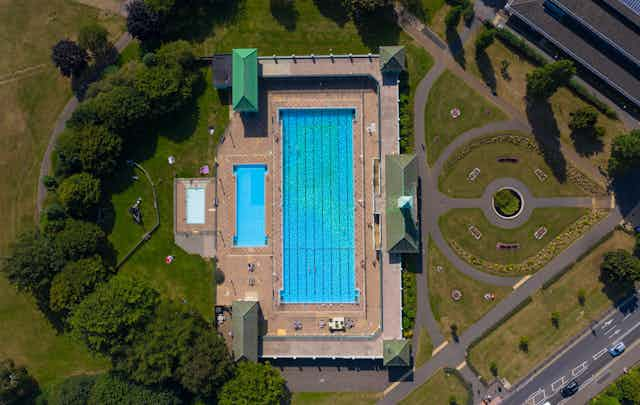The oldest outdoor swimming pool in the UK – the Grade II listed Cleveland Pools in Bath which first opened in 1815 – will reopen during the summer of 2023, after significant restoration. With a new 50-metre outdoor pool having opened in Brighton) in June and a council-funded restoration under way in Hull, the simple pleasure of the public outdoor pool is seeing a return to popularity to the UK.
In the early 20th century, an explosion of new outdoor pools opened across Britain. Taking the name “lido” from the Italian word for coastline, the boom of construction in the 20th century was part of the post-war public works programme, which aimed to create jobs and promote health. While indoor pools had been gender segregated, public lidos were deliberately mixed and became synonymous with fun and socialising.
Lidos at coastal towns such as Scarborough and Blackpool were destinations for residents and tourists. Lido design between the 1920s and 1940s was innovative and drawn from exotic sources, such as European resorts and cruise ships. They incorporated sumptuous sundecks, sophisticated outdoor restaurants and cafes, alongside vast inviting bathing areas. Impressive diving boards challenged those brave enough to leap theatrically and please the crowds. These lidos were able to accommodate thousands of visitors as wholesome, accessible leisure destinations.
Some of the most iconic lidos are the magnificent art deco sites in Saltdean, Plymouth and Penzance in the south of England. These stunning sites have thankfully been saved from demolition, many others were not. Lido lovers remain hopeful that another art deco site, Broomhill in Ipswich, will one day be restored.
Lidos were grand constructions and monuments of civic pride, both for those who created them and for those who frequented them. They reflected times of change in society and great optimism. At their peak, there were more than 300 active public outdoor pools in the UK, with 11 in Liverpool and 68 in London.

Lidos closures
The 1960 Wolfenden report, Sport and the Community and the 1968 Sports Council report Planning for Sport were catalysts for the demise of outdoor swimming pools in policy. The mandate was that “as a general rule, [pools] should be indoors”.
Lidos fell into disrepair and were steadily replaced or destroyed, after councils no longer saw them as part of their leisure facilities and reduced or stopped funding. At the turn of the century, only around 130 public outdoor pools remained, predominately in the south of the UK. That number hardly changed in the following two decades.
The steady loss of these lidos didn’t go unnoticed. The Thirties Society’s report Farewell my Lido (1991) and then Janet Smith’s important 2005 English Heritage-funded book Liquid Assets (with a forthright foreword from artist Tracey Emin) document the history and argued passionately for a brighter future for these much-loved public luxuries.
But as local councils faced financial crises in 2008 and central government reduced spending further from 2010, leisure was treated differently. Responsibility for lidos was transferred to charitable trusts. Those that remained were preserved and saved by community groups or trusts and some local authorities, who understood their public value.
During the last two decades – and recently accelerated by the COVID-19 pandemic where outdoor swimming was one of the few activities allowed for a while – there has been a steady growth in outdoor, wild and lido swimming.
And there are cultural markers of a resurgence, too. Fashion label Radley created a limited-edition lido handbag in 2016. In 2019, crowdfunding helped create The Lido Guide. The same year, a heart-warming novel, The Lido by Libby Page, beautifully captured the community spirit, history and value of lidos.
Photographer Christopher Beanland paid homage to lidos in 2020 through a global collection of outdoor pools and their stories. And then this year, Brit Pop band Blur choose the iconic 2014 Martin Parr image of a solitary swimmer in Gourock Pool for the cover of their upcoming album, The Ballad of Darren.
Over 30 lido schemes have emerged from 2021 onwards. They’ve been nurtured by the Future Lidos Group and their National Heritage Lottery funded pooling resources project. The design emphasis is once again on innovation, taking the lessons of lido heritage and the human connection which formed in these inclusive sites into consideration.
If Sport England’s policies can recognise the diverse value of lidos to public health and leisure, the next decade could see a further resurgence in restorations. Even more lidos could soon be making a welcome return across Britain, allowing more access to outdoor swimming – whatever the weather.

